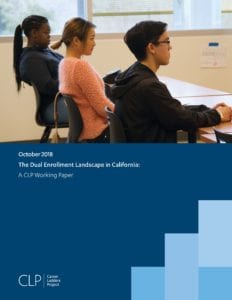A CLP Working Paper
 Multiple studies have shown that students who participate in high-quality dual enrollment programs during high school are more likely to graduate, enter college, and persist in college to completion. Students who are most underrepresented in community colleges — young men of color, students from low-income families, and students who are the first in their families to attend college — often benefit the most (Cowan & Goldhaber, 2013; Karp et al., 2007; Rodriguez, Hughes, & Belfield, 2012; Speroni, 2011; Struhl & Vargas, 2012). Dual enrollment also provides an introduction to higher education for firstgeneration college students and their families. It offers a low- or no-cost way to earn credit and may help students obtain degrees faster. And it meets the goals of guided pathways, a national reform movement that provides a framework for achieving ambitious student completion and equity goals by redesigning the college experience from the student’s perspective.
Multiple studies have shown that students who participate in high-quality dual enrollment programs during high school are more likely to graduate, enter college, and persist in college to completion. Students who are most underrepresented in community colleges — young men of color, students from low-income families, and students who are the first in their families to attend college — often benefit the most (Cowan & Goldhaber, 2013; Karp et al., 2007; Rodriguez, Hughes, & Belfield, 2012; Speroni, 2011; Struhl & Vargas, 2012). Dual enrollment also provides an introduction to higher education for firstgeneration college students and their families. It offers a low- or no-cost way to earn credit and may help students obtain degrees faster. And it meets the goals of guided pathways, a national reform movement that provides a framework for achieving ambitious student completion and equity goals by redesigning the college experience from the student’s perspective.
Despite all these advantages, California has not committed to dual enrollment as a strategy to encourage college completion. In fact, it lags national averages. California community colleges implementing dual enrollment encounter significant barriers. And navigating dual enrollment can be challenging for students, K-12 schools, and college staff and administrators.
Prepared by Career Ladders Project
October 2018